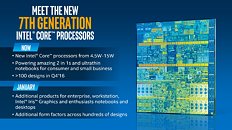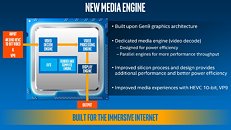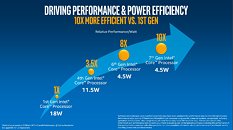Tuesday, August 30th 2016

Intel Announces the First 7th Generation Core Processors
Intel takes computing to the next level with the 7th Gen Intel Core processor family. The 7th Gen Intel Core processors are designed for the immersive Internet and built on a strong foundation of the Skylake microarchitecture. Intel's latest 14 nm processors deliver more responsive performance than ever, fantastic entertainment and gaming, robust security, and even more natural, intuitive interactions with your PC. With incredible improvements that transform the viewing experience with 4K UHD videos, 360-degree videos , multiple video streams, and premium content playback, the 7th Gen Intel Core processors for mobile platforms enable a new way to enjoy the sharp and engaging content across a range of form factors.
Intel scales 7th Gen Intel Core processors to a variety of PC designs at a wide range of price points, which may include features such as Thunderbolt 3 USB Type-C single-wire connection, low power premium audio and hassle-free facial recognition such as Windows Hello. Users can also expect to see PC designs based on 7th Gen Intel Core processors with a variety of intuitive input options such as touch, voice, and stylus.This means you can
RESPONSIVE PERFORMANCE. 7th Gen Intel Core processors utilize a power-efficient microarchitecture, advanced process technology and silicon optimizations to deliver faster performance than previous generation processors. Web browsing is snappy and responsive with Intel Speed Shift Technology. On processors with Intel Turbo Boost 2.0 Technology, performance and power is dynamically controlled - for cores and graphics - boosting performance precisely when it is needed, and saving energy when it counts. Both the Y-series and U-series processors support two cores and four threads with Intel Hyper-Threading Technology (Intel HT Technology), enabling compelling 2 in 1 designs and thin clamshells that achieve a unique balance between performance and mobility. PCs enabled with Microsoft Windows Modern Standby are able to wake immediately at the push of a button, so users don't have to wait for their system to start up.
RICH, IMMERSIVE EXPERIENCE. Intel HD Graphics deliver advanced performance and the new media engine for captivating visuals.3 With 7th Gen Intel Core processors, users can easily watch, create, edit,share and game. With the ability to view premium content up to 4K UHD from more vendors, the 7th Gen Intel Core processor family allows users to enjoy amazing and vibrant multimedia experiences on compatible displays. It also enables powerful photo and video editing, multiple video streams, 360-degree videos, and high-resolution video chat. In addition, users can play their favorite PC games on the go in HD with fluid, texture-rich graphics. Finally, thanks to our new media engine with power-efficient VP9 and HEVC 10-bit hardware acceleration, 4K viewing and content creation is significantly improved versus previous generation processors.
SIMPLICITY AND CONVENIENCE. Notebooks with the versatile Thunderbolt 3 technology, the USB-C that does it all, provide an incredible I/O experience. A single cable conveniently supports up to 40 Gbps transfer speeds, two 4K 60 Hz displays, system charging up to 100W, external graphics, and Thunderbolt networking to bolster productivity. More designs supporting touch, voice and stylus input, intuitive interaction becomes prevalent with 7th Gen Intel Core processors, enabling users to simplify their interactions and unleash their creativity. On notebooks with cameras supporting Windows Hello facial recognition, users are able to securely log into a PC and websites hassle free.
EXTENDED BATTERY LIFE. With the 7th Gen Intel Core processor family further improving power efficiency at a processor and platform level, 7th Gen Intel Core processor-based systems have longer battery life and can utilize smaller batteries to enable even thinner and lighter systems. Dedicated
hardware acceleration reduces power consumption dramatically, enabling 3X longer battery life during local 4K video playback. With the Y-processor family, 2 in 1s and clamshells are reimagined, enabling thin and fanless designs for ultra-mobility. On U-series processors, enhanced productivity and creativity are possible in increasingly slim form factors.
I/O SUPPORT. I/O in U and Y series 7th Gen Intel Core processors offers Gen 3 PCIe support, supporting higher data transfer rates of 8 GT/s versus 5 GT/s with PCIe Gen 2. The latest Intel Rapid Storage Technology supports NVMe PCIe x4 solid state drives and is capable of utilizing Gen 3 PCIe Speeds. The Intel Context Sensing SDK for the Intel Integrated Sensor Solution allows third-party software vendors to develop exciting sensor-enhanced applications.
This announcement of new 7 th Gen Intel Core processors will include
Intel scales 7th Gen Intel Core processors to a variety of PC designs at a wide range of price points, which may include features such as Thunderbolt 3 USB Type-C single-wire connection, low power premium audio and hassle-free facial recognition such as Windows Hello. Users can also expect to see PC designs based on 7th Gen Intel Core processors with a variety of intuitive input options such as touch, voice, and stylus.This means you can
- Create : Beautify 1400 photos in one minute
- Multitask : Combine multiple 4K UHD videos into a highlight reel in 4 minutes while shopping and watching a movie
- Game : Play your favorite games, like Overwatch, on-the-go, in HD
- The 7th Gen Intel Core processors enable mobile designs that will allow faster 4K UHD creation and watching and streaming of 4K UHD content longer
- New HEVC 10-bit decode capability delivers smooth premium content playback up to 4K UHD
- New VP9 decode capability allows power efficient smooth 4K UHD,4K 360-degree playback while multitasking
- Quickly and effortlessly create, edit and share 4K UHD 360° video 8X faster compared to a 5-year-old PC
- Enjoy up to 9.5 hours of 4K video playback
RESPONSIVE PERFORMANCE. 7th Gen Intel Core processors utilize a power-efficient microarchitecture, advanced process technology and silicon optimizations to deliver faster performance than previous generation processors. Web browsing is snappy and responsive with Intel Speed Shift Technology. On processors with Intel Turbo Boost 2.0 Technology, performance and power is dynamically controlled - for cores and graphics - boosting performance precisely when it is needed, and saving energy when it counts. Both the Y-series and U-series processors support two cores and four threads with Intel Hyper-Threading Technology (Intel HT Technology), enabling compelling 2 in 1 designs and thin clamshells that achieve a unique balance between performance and mobility. PCs enabled with Microsoft Windows Modern Standby are able to wake immediately at the push of a button, so users don't have to wait for their system to start up.
RICH, IMMERSIVE EXPERIENCE. Intel HD Graphics deliver advanced performance and the new media engine for captivating visuals.3 With 7th Gen Intel Core processors, users can easily watch, create, edit,share and game. With the ability to view premium content up to 4K UHD from more vendors, the 7th Gen Intel Core processor family allows users to enjoy amazing and vibrant multimedia experiences on compatible displays. It also enables powerful photo and video editing, multiple video streams, 360-degree videos, and high-resolution video chat. In addition, users can play their favorite PC games on the go in HD with fluid, texture-rich graphics. Finally, thanks to our new media engine with power-efficient VP9 and HEVC 10-bit hardware acceleration, 4K viewing and content creation is significantly improved versus previous generation processors.
SIMPLICITY AND CONVENIENCE. Notebooks with the versatile Thunderbolt 3 technology, the USB-C that does it all, provide an incredible I/O experience. A single cable conveniently supports up to 40 Gbps transfer speeds, two 4K 60 Hz displays, system charging up to 100W, external graphics, and Thunderbolt networking to bolster productivity. More designs supporting touch, voice and stylus input, intuitive interaction becomes prevalent with 7th Gen Intel Core processors, enabling users to simplify their interactions and unleash their creativity. On notebooks with cameras supporting Windows Hello facial recognition, users are able to securely log into a PC and websites hassle free.
EXTENDED BATTERY LIFE. With the 7th Gen Intel Core processor family further improving power efficiency at a processor and platform level, 7th Gen Intel Core processor-based systems have longer battery life and can utilize smaller batteries to enable even thinner and lighter systems. Dedicated
hardware acceleration reduces power consumption dramatically, enabling 3X longer battery life during local 4K video playback. With the Y-processor family, 2 in 1s and clamshells are reimagined, enabling thin and fanless designs for ultra-mobility. On U-series processors, enhanced productivity and creativity are possible in increasingly slim form factors.
I/O SUPPORT. I/O in U and Y series 7th Gen Intel Core processors offers Gen 3 PCIe support, supporting higher data transfer rates of 8 GT/s versus 5 GT/s with PCIe Gen 2. The latest Intel Rapid Storage Technology supports NVMe PCIe x4 solid state drives and is capable of utilizing Gen 3 PCIe Speeds. The Intel Context Sensing SDK for the Intel Integrated Sensor Solution allows third-party software vendors to develop exciting sensor-enhanced applications.
This announcement of new 7 th Gen Intel Core processors will include
- Intel Core m3 processor
- Intel Core i3, Intel Core i5 and Intel Core i7 processors







44 Comments on Intel Announces the First 7th Generation Core Processors
Lol.
www.extremetech.com/mobile/221881-apples-a9x-goes-head-to-head-against-intels-core-m-in-arm-x86-grudge-match
So only in tasks that require high amounts of cache and or specialized hardware does Intel pull ahead. So.....
I really hope the future Android phones will not be laggy crap with 32 slow cores while apps use 2 at most.
You got what you payed for. Android isn't at fault carrying also budget hardware.
Nexus and flagship phones are perfectly fine since snapdragon 800. Get some reason. These mobile chips are more sophisticated than intel ones in the igpu and media engine considering the power envelope Intel is lagging a year behind already.
As for the actual kaby lake cpus, no I'll pass.
I bet pre 25 year old gammers that water cool everything and run windows 10 will have hard ons for these new CPU's..
While the rest of use couldn't give a rats...
Sandy Bridge now that was a big step.. everything since this has been yawn...
Only thing id like to see the power usage of the new CPU's.
:mad:
There are only a few E3-Xeons with iGPUs. All the other E5 and E7 Xeons for example don't have iGPUs, not even disabled ones. Heck, even the Xeon-D does not have an iGPU!
Kidding.
Sure, the list of applications that utilize multiple compute resources is stacked with professional applications or ones developed by large teams but that is ever changing. The immense effort Intel has put in and continues to put in will pay off as heterogeneous computing becomes ubiquitous like say, SIMD. This was a big deal back in the late 90's; you tried out Planet of Death to see an MMX game in action, whether you liked the genre or not. Now, whatever it's utilizing behind the scenes doesn't get much press unless you're the first.
That's precisely y I got a Xeon 1230v3